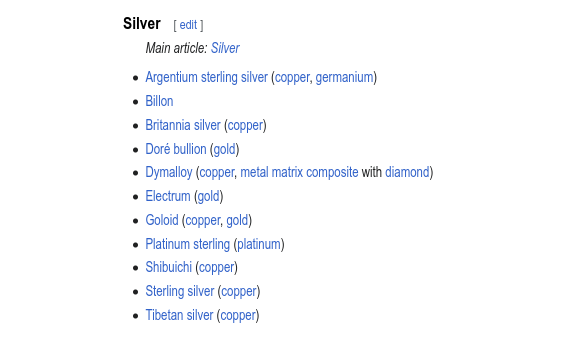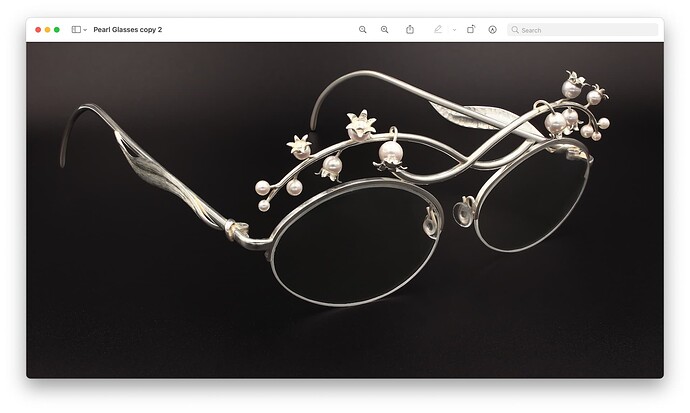I have been using quite a lot of fine silver, in addition to sterling. I’ve now added argentium as well, and as a result I’m spending a lot of time explaining the differences to my customers. I’m making a little sheet to give people to cut down on this a bit, with just the most pertinent info about each. I thought I’d mention that there are other types as well (since an awful lot of people think sterling is pure silver), but when I googled how many types there are the answers varied wildly. Does anyone know how many there are, or how many are typically used in jewelry? Thanks, Sue
From wikipedia. Is it the color that people are looking for or the alloy.

Thanks. If I understand your question, at my table we’re just talking about silver-coloured silver. That’s confusing enough for them ![]()
Most people find it interesting. Some think they know but don’t, I have some perplexing conversations sometimes. The other day a woman picked something up and I mentioned it was pure silver, rather than sterling, and she said (a bit dismissively) “Oh, I know, I can tell by the weight”. (I generally say “pure” with the public rather than “fine”, since pure has a clearer common meaning). People do say such odd things, to me & the other market jewelers I know. One of my favourites is “do you do any soldering?”. If you look at my display and have to ask, you don’t know what soldering is. But I just nod. The only comment that gets to me a bit is when they glance at my table and say “Oh, yes, I do some wire wrapping too”. ![]()
You’re right SueS! There are a lot of silver alloys out there these days.
I was taught that sterling silver is 92.5% fine silver and 7.5% copper. Other mixtures are possible, but I was taught that they’re not sterling silver. In recent years some folks have been playing with those proportions and metals within the composition. At this point, I’ve decided that the concept of sterling silver is more flexible than what I was taught and to view it like language, something that is always evolving.
I’m a big fan of palladium silver as a bridge metal when using a PUK, Orion or laser welder to weld sterling. Palladium silver can follow the sterling proportion of 92.5% fine silver, 7.5% palladium. I’ve also seen palladium silver have a higher percentage of palladium.
Stuller sells two proprietary silver alloys Sterilum Plus and Continuum.
Rio Grande and others folks sell a W. R. Cobb Co. de-ox sterling alloy called Sterilite, with 92.5% fine silver and a variety of other metals.
You’re going to have to do some research to track down all of the silver alloys out there. I don’t think there is a comprehensive list anywhere. But again, you’re right, there are a lot more options than just 92.5% silver and 7.5% copper!
Jeff
Can someone explain what the benefits of other alloys are and are they worth it? I see argentum, and now @jeffg-moderator shares palladium silver! I want to join the party.
I am drawn towards silver that acts more like platinum in its resistance to tarnishing but I know that’s not possible. I’ve seen some silver pieces that looks quite “white” and wonder if that’s achievable with 925 or some other alloy.
I have just started working with argentium, and I love certain things about it - especially that it fuses, like fine silver, but you can make more delicate things, because it’s not soft like fine silver. Argentium is quite a bit whiter than the others, and tarnish-resistant, at least as compared to sterling. I will continue to use sterling, fine & argentium, depending on what I’m trying to do.
Thank you. A welder isn’t an option right now, perhaps down the road if I ever have a real studio and more $. For the purposes of my customers, it’s enough for now to simply say there are quite a few varieties, and focus on the 3 I use.
I’m with Jeff. I really love palladium silver alloys. They are expensive but worth the extra cost. My fav is Continuum silver. It’s one of the, if not the strongest sterling alloy out there. So I can make very delicate pieces that really hold up. It’s a great metal for stones that are to be set in rings that will take a lot of abuse during daily wear. It fuses beautifully. And it doesn’t act as a heat soak like sterling does. So one can spot solder rather than having to heat the whole piece up. This makes soldering on pieces that have stones already set much less risky. Also you don’t have the issue of needing designated tools to avoid contamination. It also enamels well.
Good to know about the spot soldering. This is something I really love about argentium, given I only have a butane torch. I just made a 1.5" cuff with lots of fused elements, which of course I was unable to do with sterling. I’ll add palladium alloy to my list of things to learn about, thanks.
Does this alloy behave differently when pouring ingots/rolling/etc?
Two other types of silver that I have not seen mentioned yet but that you will run into frequently are Mexican silver - sometimes .925, but more often .950 - and coin silver - typically .900, especially in American coinage, pre-1964. A lot of silver coins too worn to be numismatically valuable went into jewelry pieces, particularly in the 60’s and 70’s when Hippy jewelry and “Indian” jewelry were popular.
Sterling silver just means something is at least .925/1000 parts pure silver. The rest can be anything. With that said, the most popular alternatives to traditional sterling (.075/1000 copper) are the following, in no particular order
De-ox silver (mix with other elements, zinc, germanium, indium, tin, others
Anti-firescale silver (as above, usually just zinc)
Argentium Silver (mixed with germanium I think)
Palladium Sterling
Platinum Sterling
Karat-Sterling (mixed with gold)
Some of these are patented and some are slightly higher in silver. Argentium is .935 I believe, I may be wrong.
I made the switch to mixing my own de-ox silver a while back and the results have been phenomenal for casting. No more firescale. What a relief. It’s about .928
Hi there, I have been extensively researching about alloying my own silver to promote this benefits, as I have encountered porosity issues in my vacuum castings, i use a closed electr furnace to melt the metal.
what would you reccomend in the mix apart from Silver, copper and zinc and what ratios?
As well Zinc wouldn’t just evaporate even if added at the end?
Hopefully you can share some knoledge into this as I have been picking my brains for days now!
thank you ![]()
I forgot to add that continuum can be re-used multiple times. I have a pair of eyeglasses that I made with continuum that was re-used and melted about 8 times. It also doesn’t need designated tools and surfaces to avoid contamination. If a little sterling or fine silver gets in a pour it’s no big deal.
@jhaemer52
Thanks, jo, for the info about continuum…I knew it was an alternative to argentium, but didn’t know it was good for hot spot soldering or repeated re-use.
@Monothic
I’m interested in the formula for de-ox silver for casting. Is this something you could share…or give a reference for?
Thx,
royjohn
Those glasses are great!
I have thought about making glasses before. Now I’m thinking about it again.
Sure! I use United Precious Metals Refining s57 alloy and I mix it at .928-.930.
Ah, UPM! I talked to one of their tech guys one time and he knew all kinds of stuff that was fascinating! Thx!
